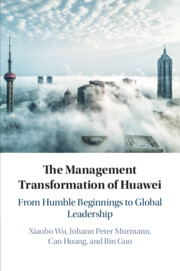Book contents
- The Management Transformation of Huawei
- The Management Transformation of Huawei
- Copyright page
- Contents
- Figures
- Tables
- Contributors
- Preface
- 1 The Management Transformation of Huawei
- 2 The Executive Management Team and Organizational Change
- 3 Transforming Product Development at Huawei
- 4 Huawei’s Transformation of Supply Chain Management
- 5 Financial Management Transformation in Huawei
- 6 The Transformation of Huawei’s HR System
- 7 Huawei’s Internationalization Journey
- 8 Huawei’s R&D Management Transformation
- 9 Huawei’s Intellectual Property Management Transformation
- 10 The Management Transformation of Huawei
- Book part
- Index
- References
6 - The Transformation of Huawei’s HR System
Published online by Cambridge University Press: 21 March 2020
- The Management Transformation of Huawei
- The Management Transformation of Huawei
- Copyright page
- Contents
- Figures
- Tables
- Contributors
- Preface
- 1 The Management Transformation of Huawei
- 2 The Executive Management Team and Organizational Change
- 3 Transforming Product Development at Huawei
- 4 Huawei’s Transformation of Supply Chain Management
- 5 Financial Management Transformation in Huawei
- 6 The Transformation of Huawei’s HR System
- 7 Huawei’s Internationalization Journey
- 8 Huawei’s R&D Management Transformation
- 9 Huawei’s Intellectual Property Management Transformation
- 10 The Management Transformation of Huawei
- Book part
- Index
- References
Summary
To facilitate its rapid growth over the past thirty years and build an increasingly capable management team and workforce, Huawei made substantial changes to its HR practices. As the number of employees increased, the firm faced different challenges in recruiting, developing, and motivating employees while broadening its geographic focus from China to all corners of the globe. To accurately describe the changes Huawei made to address these challenges, we divide the history of Huawei’s HR system into five distinct stages that we call (1) personnel management, (2) the beginning of human resource management, (3) strategic human resource management, (4) international human resource management, and (5)talent management. With the help of Western consulting firms, Huawei imported many Western HR practices and combined them with the Chinese tradition of cultivating a strong commitment to a large organization. Huawei also adapted Western ideas. For example, it required employees to pay for their own training costs at the company university.
Keywords
- Type
- Chapter
- Information
- The Management Transformation of HuaweiFrom Humble Beginnings to Global Leadership, pp. 209 - 243Publisher: Cambridge University PressPrint publication year: 2020



